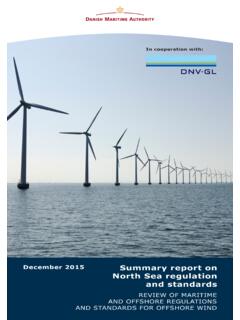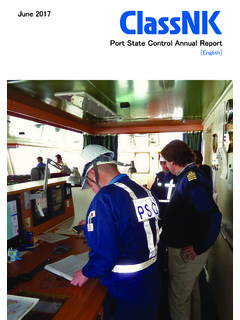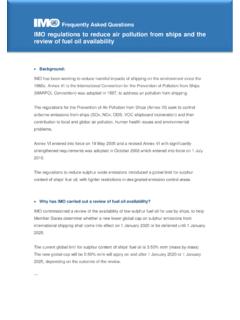Transcription of A review of current practice and evidence
1 Executive Health and Safety Offshore working time in relation to performance, health and safety A review of current practice and evidence Prepared by the University of Oxford for the Health and Safety Executive 2010 RR772 Research report Executive Health and Safety Offshore working time in relation to performance, health and safety A review of current practice and evidence Katharine R Parkes MA MSc PhD Department of Experimental Psychology University of Oxford South Parks Road Oxford OX1 3UD This report details the offshore working time arrangements in operation in the UK north Sea sector, and reviews evidence of their effects on the performance, health and safety of offshore personnel.
2 The report also includes information obtained in interviews with occupational health and safety specialists in the oil/gas industry. 1 The initial chapters outline the work patterns currently in use on north Sea installations, the legal framework of the working time regulations as applied offshore, and the physical and psychosocial demands inherent in offshore work. 2 A review of the effects of long work hours and shift work on health and safety outcomes in onshore settings is followed by a detailed presentation of findings from offshore research into work/leave schedules, day/night shift rotation, overtime hours, and their effects on performance, fatigue, alertness,sleep, and health.
3 3 The views expressed by health and safety specialists when asked about offshore work/leave schedules, shift rotation, issues of cumulative fatigue and rest offshore, and other aspects of working time arrangements, are reported. 4 The final chapter presents an overview and conclusions; it identifies optimum work patterns where possible; it notes the gaps that exist in the research literature; and it makes some general recommendations. This report and the work it describes were funded by the Health and Safety Executive (HSE). Its contents, including any opinions and/or conclusions expressed, are those of the author alone and do not necessarily reflect HSE policy.
4 HSE Books Crown copyright 2010 First published 2010 All rights reserved. No part of this publication may be reproduced, stored in a retrieval system, or transmitted in any form or by any means (electronic, mechanical, photocopying, recording or otherwise) without the prior written permission of the copyright owner. Applications for reproduction should be made in writing to: Licensing Division, Her Majesty s Stationery Office, St Clements House, 2-16 Colegate, Norwich NR3 1BQ or by e-mail to ii CONTENTS 1. INTRODUCTION 1 Work/leave schedules 1 Work hours 2 Regulation of offshore working time 4 Operational and individual risks offshore 7 Structure of the present report 8 2.
5 OFFSHORE WORK ENVIRONMENT 9 Physical and psychosocial stressors 9 Cabin accommodation 10 Travel to and from the installation 11 Adjustment to the offshore environment 11 Demographic profiles of the UK north Sea workforce 12 Medical requirements for offshore work 13 3. LONG WORK HOURS: ONSHORE STUDIES 15 12-hr shift duration 16 Overtime hours 18 Rest and recovery from fatigue 21 4. OFFSHORE WORK/LEAVE PATTERNS 23 Comparison of 2-week and 3-week offshore tours 23 Duration of shore leave periods 25 Maximum offshore work periods 27 Offshore work/leave patterns worldwide 27 iii i5.
6 OFFSHORE SHIFT WORK AND SHIFT ROTATION 29 Performance and alertness over 12-hr day shifts 29 Overtime hours 31 Night shifts 32 Rollover shift schedules 32 Comparison of offshore shift rotation patterns 34 Interventions to facilitate circadian adjustment 36 Implications of research findings for real-world risk 37 6. OFFSHORE WORK HOURS: ACCIDENT AND ILLNESS RISK 39 Accidents and injuries 39 Sleep and health measures 41 Overview of injury and illness risks 44 7.
7 OFFSHORE WORKING TIME ISSUES: INDUSTRY VIEWS 45 Introduction 45 Overview of interview material 46 8. CONCLUSIONS 51 Work/leave schedules 51 Shift duration and overtime 54 Day/night shift rotation 55 General points 56 9.
8 REFERENCES 59 iv vEXECUTIVE SUMMARY This report documents the working time patterns currently in operation on north Sea oil/gas installations, outlines the legal judgments that have sought to clarify the application of the EU Working Time Regulations (WTR) offshore, and reviews research findings and other evidence of the effects of working time patterns on the performance, health and safety of offshore personnel. In addition, drawing on interview material, the report outlines the views and attitudes expressed by senior oil industry personnel with direct experience of offshore working time issues.
9 The report thus brings together a wide range of current information, intended as a guide for the industry and regulatory authorities. Chapter 1 outlines the work/leave schedules currently in use on UK north Sea installations, noting recent moves towards longer shore breaks, specifically 2-3 schedules ( 2 weeks offshore alternating with 3 weeks shore break). However, many offshore personnel, particularly those on drilling rigs, continue to work regular equal-time patterns ( offshore weeks and shore breaks of the same duration).
10 This chapter also sets out the shift duration and day/night shift rotation patterns currently worked offshore, and the incidence of overtime hours. The regulation of offshore working time is described, including the EU Working Time Regulations (which provide the legal framework governing offshore working hours and schedules), the role of guidance notes prepared by the UK Health and Safety Executive, and the Vantage system for monitoring offshore working hours and personnel competencies. Chapter 2 describes the more general context of north Sea work, particularly the physical and psychosocial stressors to which offshore workers are exposed ( noise, vibration, cramped workspace, steep stairways, and heavy work tasks).















